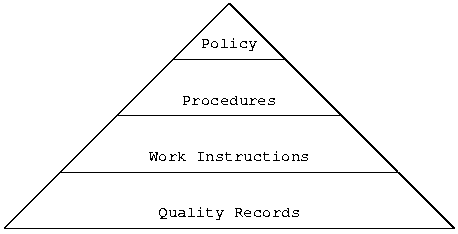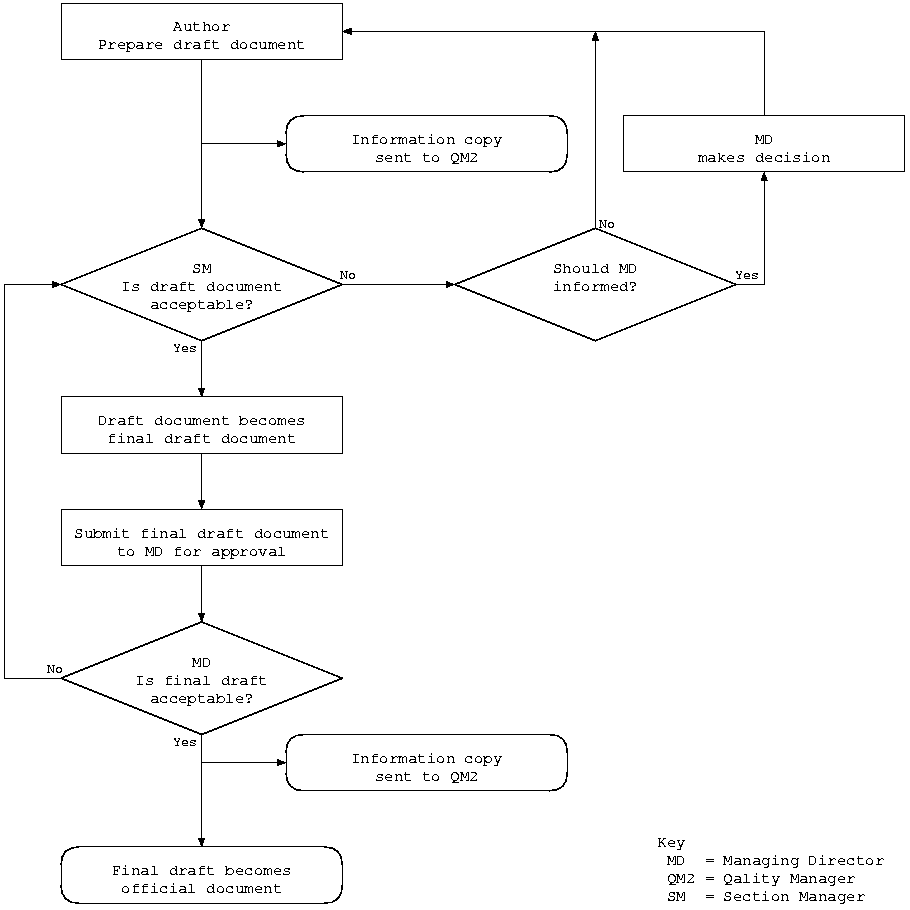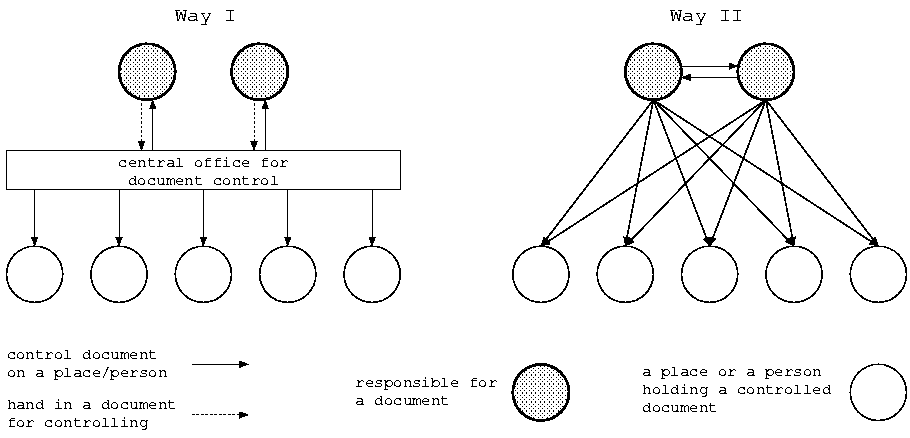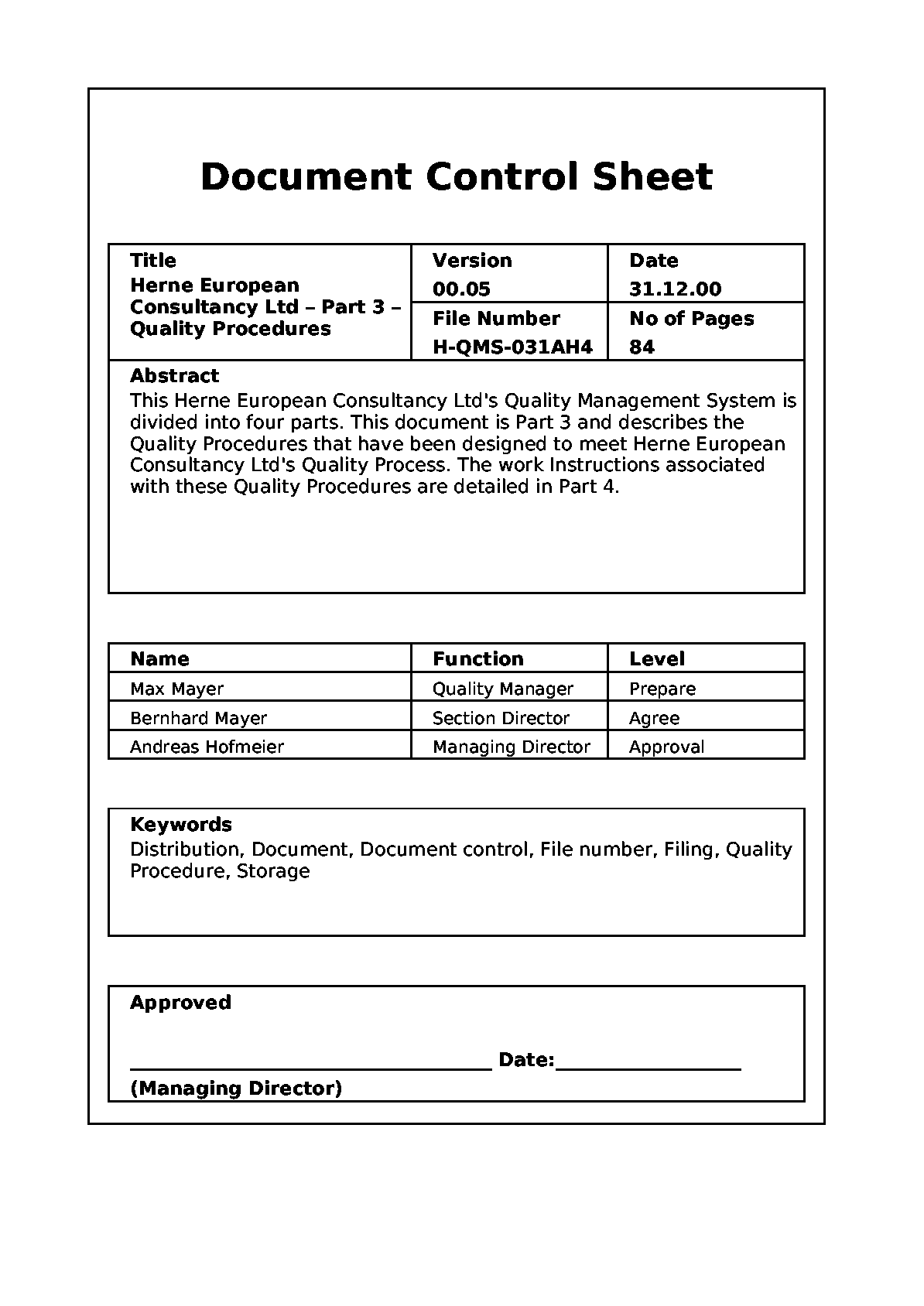
 Impressum/Note Privacy
Impressum/Note Privacy|
Pages by Andreas B. M. Hofmeier |
 |
 Impressum/Note Privacy Impressum/Note Privacy |
|---|
|
http[s]://www.abmh.de/en/papers/lsbu/Standards/Standards.HTML/index.html |
|---|
| Lecturer: | Kate Viscardi |
| Deadline: | 16.12.2004 |
| Hand-In: | 16.12.2004 |
| Student: | Andreas Hofmeier |
| Student ID: | 2406108 |
| Address: | Dante Road Student Residence |
| Room 2G3 | |
| 2 Dante Place | |
| London SE11 4RX | |
| Tele Number: | 0870 036 5618 |
| Course: | Computer Systems and Networks, |
| 3 Year, BEng, FT | |
|
Abstract
This report gives on overview about controlled documentation cohesive
with quality management (QM) and quality management systems (QMS)
respectively. Special attention was spent on small companies but there is
not so much difference to larger companies in terms of QM and QMS.
The (new) computer and informations technology (like computer networks)
makes QM affordable for everyone.
|
Quality Management is becoming more and more important because today’s customers want high-quality-products as cheaply as possible. Products which are only cheaply are no longer asked for. But what is Quality? Quality can be defined with delivering what is required (by the customers) in time. (Adapted from Munro-Faure et al 1995, ISO 9000:2000, and Ansell 1993) It is necessary to manage the process of production1 in a good way, to meet the high-quality-standards at low prices. This Management process is called ’Quality Management’ (QM). A Quality Management System (QMS) is a complete system of rules and procedures which describes how to manage quality.
There are a lot of facilities to support companies in their Quality Management. One of the biggest support-systems is the ISO9000, a international standard series. The ISO9000 defines the guidelines for Quality Management. It does not deliver a complete solution (Tricker 2001). The guidelines need to be implemented and adapted for every special single case. There is no major difference between small and bigger companies (Tricker 2001). Many books about ISO9000 are available, and supporting the implementation and adaption by giving interpretation, explanation, and examples.
To prove that the process of production is high quality, quality accreditation is carried out by official organisations such as the British Standards Institution (BSI). After the production process is checked and complains with ISO9000 (or BS57502) a seal of approval is given and can be used for advertising. In this way the customers obtain knowledge about which companies using a high-quality process to produce and deliver their products and services. (BSI, 1990)
| Figure 1: Seal of Approval from the BSI (Saint-Gobain Pipelines 2003). | |
Documentation is an important part of a Quality Management System. For this reason one part of the ISO9000 describes what documentation should be included and gives a framework for managing and controlling documentation.
Documentation is in the broadest sense all data which is meaningful and written down3 (Adapted from ISO 9000-1:1994). That can be, for example, work instruction, a contract or the results of a quality test or audit.
“A Quality Management System will only be effective if it is documented, understood and followed by all employees.” (Munro-Faure et al 1995 p55) To achieving this it is necessary that all procedures and processes are defined. In Addition these definitions must be available and understandable to all users in form of documentation so that everyone knows what s/he have to do (Clegg 2003, Munro-Faure et al 1995).
The documents in a QMS can be sorted into four levels (Jackson and Ashton 1995, Adapted from Munro-Faure et al 1995, Tricker 2001 and strategis.gc.ca 2000). The number of documents increases with the level. Note that this should give an idea, the levels do not have strict boundaries. There are a lot of difference between the interpretations.
|
 |
Figure 2: The pyramid of documentation: Illustration of hierarchy of documents. (Adapted from Munro-Faure et al 1995, Jackson and Ashton 1995, and strategis.gc.ca 2000)
A huge number of documents are necessary to maintain a Quality Management System. It is necessary to control the documentation to prevent chaos. To run a high quality process it is necessary for everyone knows what they have to do, when they have to do it, and how it is to be done. Therefore up to date documents has to be available for anyone all the time (Clegg 2003, Munro-Faure et al 1995).
Before each document can be issued it must be clear who needs it and who should receive a copy of it. It is important to find a way to keep the golden mean between minimising the number of documents on the one, and the necessary number of documents for each person on the other hand. (Munro-Faure et al 1995) If the number of documents increases, the effort which is necessary to control these documents is increasing as well. In addition to this, more documents result in more mistakes with their handling (Munro-Faure et al 1995). For example, it is simpler to have an overview over three documents than over 20. The possibility that one of three documents is forgotten is much less than one of 20. So the number of documents should be minimised but the access to these documents must be possible. It is may possible to provide the some of these documents in public places such as blackboards or common rooms. In this way, anyone can have access to the documents but does not need a own copy. In small companies one copy of a document is may be enough for the whole company.
All documents must be read and understood (Munro-Faure et al 1995). It makes no sense to produce documentation if nobody reads it or if it cannot be understood by everyone. For this reason there must be a feedback-channel. For example, everybody who is on a list for a document, has to sign that s/he has got and understood the document. This channel should be open for any comments, ideas or complaints. In plain English: “Using everybody’s ideas and expertise” (Thorn 1991 p20). Regular audits can be used to increase communication and determine if all information inside the QMS is understood well and helps to deliver high quality.
It must be clear who is responsible for any document (strategis.gc.ca, 2000). Any document needs somebody who is responsible for it. This person4 has to make sure that necessary changes are applied to the document. Be aware that this person has to have the ability and the authority to make final decisions about the document’s content. This person authorises both the original document and any change by signature. (Clegg 2003)
Tricker (1991) proposed a slightly different way to authenticate documents in his Example Quality Manual. It is distinguished between author and authorising persons (in this case Managing Director (MD) and Section Director (SD)). The SD and the MD make all decisions. The author only produces the document on the basis of this decisions and has to ask the MD for a final acceptance. The flowchart also point out that all documents have to sent to the Quality Manager (QM2) who does the QM.
 |
Figure 3: Example of a procedure for authorising (approval) of a document. (Adapted from Tricker 1991)
Everybody must be sure that the document was authorised by the right person, it must be clear who is responsible for which document. All information which is necessary to be sure about this (Title, unique ID number, version, who is responsible, date of first and last issue) can be stored in a document, called master list. The master list has to be controlled itself. (Clegg 2003, Munro-Faure et al 1995)
Keep record of all documents. All changes to controlled documents have to be documented itself (strategis.gc.ca, 2000). In addition to this, all versions of any document must be “archived [legible and incorruptible] for historical and legal reasons” (Clegg 2003) This is important and should provide the proof that the QMS operates effectively. (Clegg 2003, Munro-Faure at al 1995)
There are two main ways to deliver a document and make sure that all points under issuing documents are taken in account. The first is, that a central office controls the document. This office takes care that all documents are delivered and controlled. All changes have to be sent to this office. In the second scenario the responsible person takes care of the delivery and the control of all assigned documents (Munro-Faure et al 1995). A central office cannot be afforded by most small companies. For this reason the second option is more common in this companies. This method can spread the workload for the QM on more than one person. On the other hand, it may have the result that the process is less consistent (Munro-Faure et al 1995).
 |
Figure 4: Visualisation of the two different ways of delivering and controlling a document.
It must be ensured that all old documents are withdrawn from the circulation (Clegg 2003). Nobody should work with old documents. Munro-Faure et al (1995) pointed out, that it is a effective way to remove obsolete documents in the same way and at the same time as new documents are delivered.
The layout of the documents should be similar because this makes it easier to follow the document. A similar structure helps to find a particular peace of information in a document because it is alway in the same order. That reduces the possibility of mistakes (Munro-Faure et al 1995, strategis.gc.ca 2000). Do not use more detail than necessary, “use simple, clear language, with short sentences” instead (strategis.gc.ca 2000 p58 (p2 in PDF)). Every document must be clearly identifiable. If every document has a unique identification (ID) number and a version number, it can be referred unambiguously (Tricker 2001, Munro-Faure et al 1995). Use section numbers instead of page numbers for referring, that makes the documents easier to change (strategis.gc.ca, 2000). It is important, that it can be checked simply if the document is complete (all pages are present). This can be simple provided by numbering the pages. For example “’1 of n’, ’2 of n’, ’3 of n’ and so forth” (Munro-Faure et al 1995 p144), or 1/n (Jackson and Ashton 1995). n is equal to the total number of pages of the document. All the mentioned details should have a suitable place in the documents. Tricker (2001), for example, recommend a Document Control Sheet for every document, which contains: document title, version block, date, file number, number of pages, abstract, approval control block (signature of managing director and date).
 |
Figure 5: Example of a Document Control Sheet. (Adapted from Tricker 1991)
Since the 1980s the computer has become more and more important in document management systems such as QMS (Clegg 2003). Today the computer technology is available for nearly everyone, because of the dramatic fallen prices. Today’s document control software provides many more functions than required by the ISO 9000 (Clegg 2003). This technology is becoming more integrated in standard computer applications like office applications. This makes the usage of this kind of system easier (Clegg 2003). It is important that the documentation, which is stored in computers, follows also a standard. The file format and the file-system-structure5 should for example specified (Tricker 2001). Tricker (2001) pointed out that e-mails and other documents of communication must be controlled as well and give same examples in his Example Quality Manual.
The new information technologies make high quality management affordable for everyone. These technologies provide the flexibility which is needed to serve the purpose of managing documentation for constantly changing requirements in a fast changing environment (market). Small companies are not longer excluded from high quality documentation management systems.
There are a lot of aids and other materials in form of examples and explanations of the ISO standards available. Many books, for example Tricker (2001), give a complete example of an Quality Manual. Such examples can be simply adapted and are applicable for almost every company. For this reason it is possible to obtain the first level of documentation quite easily, so no company (also the smaller ones) need to create the QMS from scratch. The other three levels of documentation cannot adapted so similar because these are too special. Small companies have the advantage, that there are no so much documents needed for this levels, because of the simpler structure. Therefore a small company should not have problems to adapt a QMS.
Ansell, T. (1993) Managing for Quality in the Financial Service Industry London: Chapman & Hall ISBN 0-4124-7300-3
BSI (1990) In business to be the best; Quality assurance through regular assessments; conformity to standards within systems: Shell UK, Sabre Safety, Racon. [Videocasette]
BSI (2000a) BS EN ISO 9000:2000 Quality management systems. Fundamentals and vocabulary London: BSI
BSI (1994) BS EN ISO 9000-1:1994 Quality management and quality assurance standards. Guidelines for selection and use. London: BSI
BSI (1997) BS ISO 9000-2:1997 Quality management and quality assurance standards. Generic guidelines for the application of ISO 9001, ISO 9002 and ISO 9003 London: BSI
BSI (2000b) BS EN ISO 9001:2000 Quality management systems. Requirements London: BSI
Cherry, L.L. and Vesterman, W. (1998) STYLE(1) – Manual Page – analyse
surface characteristics of a document [Online]
Accessable at http://www.sunsite.ualberta.ca/Documentation/Gnu/diction-0.7/
man/style.1.html (accessed 12 December 2004)
Clegg, J. (2003) Document Control Systems Evolve [Online]
Available at http://www.qualitymag.com/CDA/ArticleInformation/features/
BNP__Features__Item/0,6425,108249,00.html (accessed 9 December 2004)
Jackson, P and Ashton, D (1995) Managing a Quality System Using BS / EN / ISO 9000 (formerly BS 5750) London: Kogan Page ISBN 0-7494-1443-X
Munro-Faure, L; Munro-Faure, M; Bones, E. (1995) Achieving the new international quality standards : a step-by-step guide to BS EN ISO9000 United Kingdom: Pitman Publishing ISBN 0-2736-1977-2
Philip, M (1994) BS5750/ISO9000 Made Plain – How to install BS5750 / ISO / 9000 in your company United Kingdom: Stanley Thornes Ltd ISBN 0-7487-1700-5
Rothery, B (1993) ISO 9000 2nd ed United Kingdom: Gower Press ISBN 0-566-07402-8
Saint-Gobain Pipelines (2003) Quality Assurance: Commitment to Quality
[Online]
Available at http://www.classicalrainwater.co.uk/benefits/quality.cfm (accessed 12
December 2004)
strategis.gc.ca (2000) Managing Documentation: Principles [Online]
Available at http://strategis.ic.gc.ca/pics/bp/is986e.pdf (accessed 10 December
2004)
Thorn, J (1991) Managing for Total Quality London: The Industrial Society Press ISBN 0-8529-0808-3
Tricker, R (2001) ISO 9001:2000 for Small Businesses 2nd ed United Kingdom: Butterworth-Heinemann ISBN 0-7506-4882-1
The word count and readability analysis was made with style, a program which “analyse[s] surface characteristics of a document” (Cherry and Vesterman, 1998). The parts Bibliography, Contents, Annex: Word Count and the figures are excluded from this analysis.
readability grades:
Kincaid: 9.7 ARI: 10.3 Coleman-Liau: 13.1 Flesch Index: 56.1 Fog Index: 13.4 1. WSTF Index: 2.0 Wheeler-Smith Index: 27.9 = school year 7 Lix: 45.8 = school year 8 SMOG-Grading: 12.1 sentence info: 11258 characters 2297 words, average length 4.90 characters = 1.58 syllables 133 sentences, average length 17.3 words 39% (53) short sentences (at most 12 words) 12% (17) long sentences (at least 27 words) 22 paragraphs, average length 6.0 sentences 1 questions longest sent 46 wds at sent 13; shortest sent 1 wds at sent 8 sentence beginnings: pronoun (23) interrogative pronoun (1) article (40) |
|
Pages by Andreas B. M. Hofmeier |
 |
 Impressum/Note Privacy Impressum/Note Privacy |
|---|
|
http[s]://www.abmh.de/en/papers/lsbu/Standards/Standards.HTML/index.html |
|---|
 |
(c) Andreas B. M. Hofmeier This work is licensed under a Creative Commons Attribution-Noncommercial-Share Alike 3.0 Germany License |